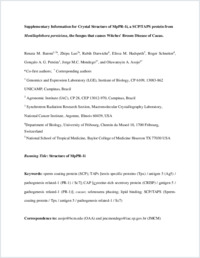Crystal structure of MpPR-1i, a SCP/TAPS protein from Moniliophthora perniciosa , the fungus that causes witches’ broom disease of cacao
- Baroni, Renata Moro Genomics and Expression Laboratory (LGE), Institute of Biology, UNICAMP, Campinas, Brazil - Agronomic Institute (IAC), Campinas, Brazil
- Luo, Zhipu Synchrotron Radiation Research Section, Macromolecular Crystallography Laboratory, National Cancer Institute, Argonne, USA
- Darwiche, Rabih Department of Biology, University of Fribourg, Switzerland
- Hudspeth, Elissa M. National School of Tropical Medicine, Baylor College of Medicine, Houston, USA
- Schneiter, Roger Department of Biology, University of Fribourg, Switzerland
- Pereira, Gonçalo A. G. Genomics and Expression Laboratory (LGE), Institute of Biology, UNICAMP, Campinas, Brazil
- Mondego, Jorge M. C. Agronomic Institute (IAC), Campinas, Brazil
- Asojo, Oluwatoyin A. National School of Tropical Medicine, Baylor College of Medicine, Houston, USA
-
10.08.2017
Published in:
- Scientific Reports. - 2017, vol. 7, no. 1, p. 7818
English
The pathogenic fungi Moniliophthora perniciosa causes Witches’ Broom Disease (WBD) of cacao. The structure of MpPR-1i, a protein expressed by M. perniciosa when it infects cacao, are presented. This is the first reported de novo structure determined by single-wavelength anomalous dispersion phasing upon soaking with selenourea. Each monomer has flexible loop regions linking the core alpha-beta-alpha sandwich topology that comprise ~50% of the structure, making it difficult to generate an accurate homology model of the protein. MpPR-1i is monomeric in solution but is packed as a high ~70% solvent content, crystallographic heptamer. The greatest conformational flexibility between monomers is found in loops exposed to the solvent channel that connect the two longest strands. MpPR-1i lacks the conserved CAP tetrad and is incapable of binding divalent cations. MpPR-1i has the ability to bind lipids, which may have roles in its infection of cacao. These lipids likely bind in the palmitate binding cavity as observed in tablysin-15, since MpPR-1i binds palmitate with comparable affinity as tablysin-15. Further studies are required to clarify the possible roles and underlying mechanisms of neutral lipid binding, as well as their effects on the pathogenesis of M. perniciosa so as to develop new interventions for WBD.
- Faculty
- Faculté des sciences et de médecine
- Department
- Département de Biologie
- Language
-
- English
- Classification
- Biological sciences
- License
- License undefined
- Identifiers
-
- RERO DOC 305619
- DOI 10.1038/s41598-017-07887-1
- Persistent URL
- https://folia.unifr.ch/unifr/documents/306073
Other files
Statistics
Document views: 82
File downloads:
- sch_csm.pdf: 154
- sch_cm_sm.pdf: 115

